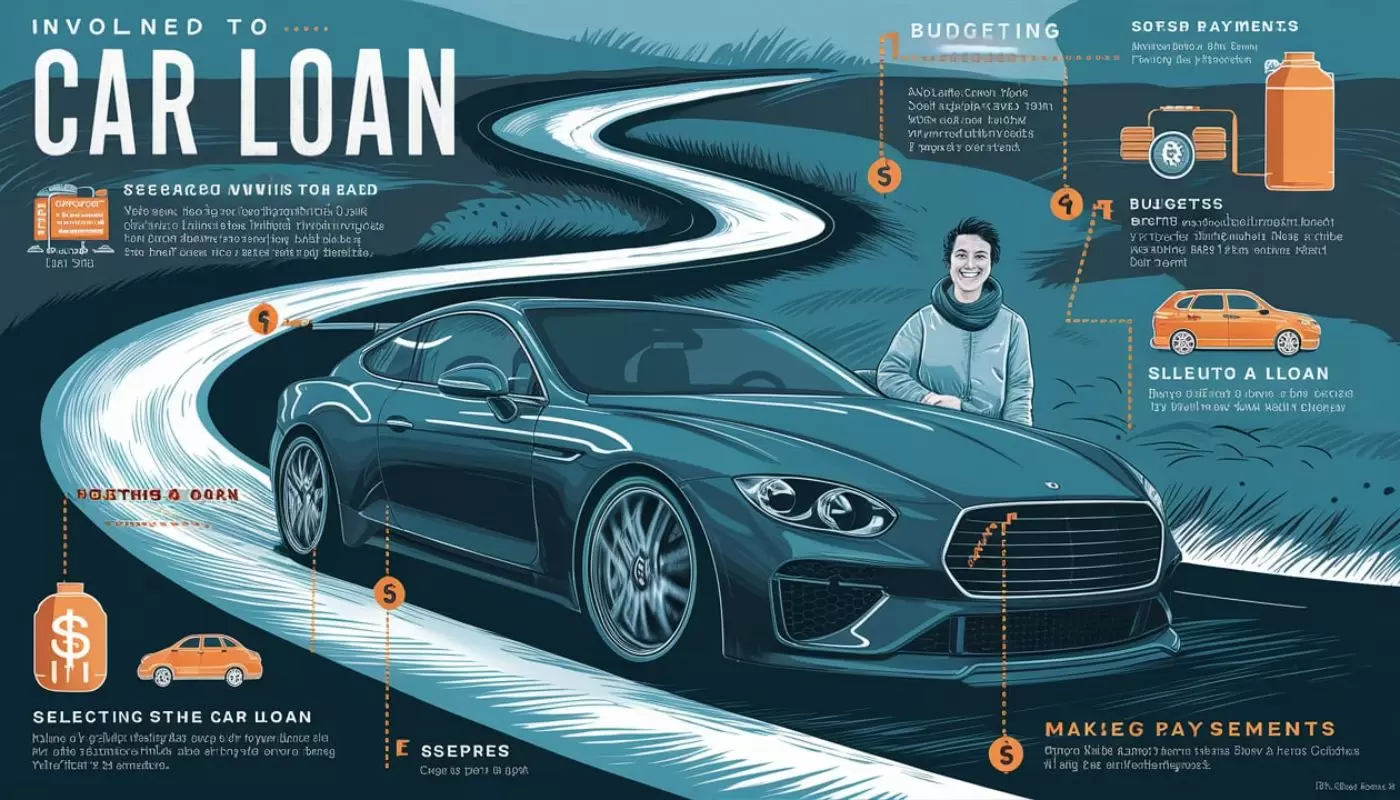Have you ever found yourself daydreaming about cruising down the Pacific Coast Highway in a sleek new ride? For most of us, that dream car comes with a hefty price tag. That’s where car loans come in. But how exactly does a car loan work? Let’s dive into the world of auto financing and unravel the mysteries of car loans.
The Basics of Car Loans: Your Ticket to the Open Road
At its core, a car loan is a financial agreement between a borrower (that’s you) and a lender. It’s a way to finance the purchase of a vehicle when you don’t have the full amount in cash. The lender provides the funds to buy the car, and you agree to pay back the loan, plus interest, over a set period.
Here’s the cast of characters in this financial drama:
- The Borrower: That’s you, the person looking to buy a car.
- The Lender: This could be a bank, credit union, or online lender.
- The Dealer: Often plays a role in facilitating financing.
Most car loans are secured loans, meaning the vehicle itself serves as collateral. If you fail to make payments, the lender can repossess the car. This security for the lender often results in lower interest rates compared to unsecured loans.
Breaking Down the Components of a Car Loan
Let’s pop the hood and examine the key parts of a car loan:
- Principal: The amount you borrow to buy the car.
- Interest Rate: The cost of borrowing, expressed as a percentage.
- Loan Term: The length of time you have to repay the loan.
- Monthly Payments: The amount you pay each month, including principal and interest.
Here’s a simple table to illustrate how these components might look:
| Component | Example |
| Principal | $25,000 |
| Interest Rate | 4.5% APR |
| Loan Term | 60 months |
| Monthly Payment | $466 |
Remember, these numbers can vary widely based on factors like your credit rating, the lender, and current market conditions.
The Car Loan Process: From Dream to Drive

Getting a car loan isn’t as daunting as it might seem. Here’s a step-by-step breakdown:
- Check Your Credit Score: Your credit score is like your financial report card. It plays a huge role in determining your interest rate and loan terms.
- Shop Around: Don’t settle for the first offer you get. Compare rates from different lenders to find the best deal.
- Get Pre-Approved: This gives you a clear idea of your borrowing power and can strengthen your position when negotiating with dealers.
- Negotiate the Car Price: Remember, the loan amount isn’t just about the car’s sticker price. It includes taxes, fees, and any add-ons.
- Finalize the Loan: Once you’ve agreed on a price, you’ll complete the loan paperwork. Read everything carefully before signing!
Types of Car Loans: Choose Your Financial Vehicle
Just like cars, loans come in different models. Here are the main types:
- Direct Lending: You get a loan directly from a bank, credit union, or online lender.
- Dealership Financing: The dealer acts as a middleman between you and the lender.
- Lease Buyouts: If you’re leasing a car and want to buy it at the end of the lease, you can get a loan for the purchase amount.
- Refinancing: You take out a new loan to pay off your existing car loan, ideally at a lower interest rate.
Each type has its pros and cons. For example, dealership financing might be more convenient, but direct lending often offers better rates.
Factors Affecting Car Loan Terms: What’s Driving Your Rate?
Several factors influence the terms of your car loan:
- Credit Score: A higher score typically means lower interest rates.
- Down Payment: A larger down payment can lead to better loan terms.
- New vs. Used: New cars often come with lower interest rates but higher overall costs.
- Market Conditions: Current economic factors can affect interest rates.
Let’s look at how credit scores might affect interest rates:
| Credit Score Range | Average Interest Rate |
| 781-850 (Excellent) | 2.6% |
| 661-780 (Good) | 3.59% |
| 601-660 (Fair) | 6.39% |
| 501-600 (Poor) | 11.03% |
| 300-500 (Very Poor) | 14.59% |
Note: These rates are examples and can vary based on lender and market conditions.
Understanding APR in Car Loans: The True Cost of Borrowing

When shopping for a car loan, you’ll often see the term APR, or Annual Percentage Rate. But what exactly is APR, and how does it differ from the interest rate?
APR includes not just the interest rate, but also other costs associated with the loan, such as:
- Origination fees
- Documentation fees
- Other charges from the lender
This makes APR a more comprehensive measure of the loan’s cost. When comparing loan offers, always look at the APR, not just the interest rate.
“APR is like the full menu price of your loan, while the interest rate is just the cost of the main course.” – Financial advisor Jane Doe
Tips for Getting the Best Car Loan: Navigating the Financial Highway
Want to secure the best possible car loan? Here are some top tips:
- Boost Your Credit Score: Pay down existing debts and correct any errors on your credit report.
- Save for a Larger Down Payment: This reduces the amount you need to borrow.
- Keep the Loan Term Short: While longer terms mean lower monthly payments, you’ll pay more in interest over time.
- Read the Fine Print: Understand all fees and terms before signing.
- Consider Pre-Payment Penalties: Some loans charge fees for paying off the loan early.
Remember, the goal is to find a loan that fits your budget now and in the future.
Common Car Loan Pitfalls: Watch Out for These Financial Potholes
Even savvy borrowers can fall into these common traps:
- Focusing Only on Monthly Payments: Lower payments often mean a longer term and more interest paid overall.
- Overlooking Fees: Some loans come with hidden charges that can add up quickly.
- Falling for Predatory Lending: Be wary of deals that seem too good to be true.
- Overextending Your Budget: Just because you can borrow more doesn’t mean you should.
Alternatives to Traditional Car Loans: Exploring Different Routes
While traditional car loans are the most common way to finance a vehicle, they’re not the only option. Consider these alternatives:
- Peer-to-Peer Lending: Borrow directly from individuals through online platforms.
- Personal Loans: Unsecured loans that can be used for any purpose, including buying a car.
- Home Equity Loans: Use the equity in your home to finance your car purchase.
- Paying Cash: If you can save up the full amount, you’ll avoid interest altogether.
Each option has its own set of pros and cons, so weigh them carefully against your financial situation.
Managing Your Car Loan: Staying in the Driver’s Seat

Once you have your car loan, proper management is key:
- Make Timely Payments: Late payments can hurt your credit score and lead to fees.
- Understand Early Payoff Options: Some loans offer savings for paying off early, while others charge penalties.
- Deal with Financial Hardships Proactively: If you’re struggling to make payments, contact your lender immediately to discuss options.
Case Study: The Impact of Loan Terms
Let’s look at how different loan terms can affect the total cost of a car:
Scenario: Buying a $25,000 car with a 4.5% APR
| Loan Term | Monthly Payment | Total Interest Paid | Total Cost |
| 36 months | $745 | $1,820 | $26,820 |
| 60 months | $466 | $3,960 | $28,960 |
| 72 months | $400 | $4,800 | $29,800 |
As you can see, a longer loan term means lower monthly payments, but a higher total cost over time.
The Future of Car Loans: What’s Down the Road?
The world of auto financing is evolving. Here are some trends to watch:
- Digital Lending: More loans are being processed entirely online.
- AI-Powered Approval: Artificial intelligence is streamlining the approval process.
- Flexible Terms: Some lenders are offering more customizable loan terms.
- Electric Vehicle Incentives: Special financing deals for eco-friendly cars are becoming more common.
Conclusion: Your Journey to Car Ownership
Understanding how car loans work is crucial for making informed decisions about auto financing. By grasping the key components of a loan, shopping around for the best rates, and avoiding common pitfalls, you can navigate the car-buying process with confidence.
Remember, a car loan is more than just a means to an end – it’s a significant financial commitment. Take the time to research, compare options, and choose a loan that aligns with your budget and financial goals.
So, are you ready to hit the road in your new car? With this knowledge under your belt, you’re well-equipped to make a smart, informed decision about your auto financing. Happy driving.
As the founder of TrustArmorInsurance, [Admin] the site in 2024 to offer reliable insurance solutions with a focus on trust and security. With a commitment to providing top-notch coverage and personalized service, TrustArmorInsurance aims to meet diverse needs with integrity and professionalism.











